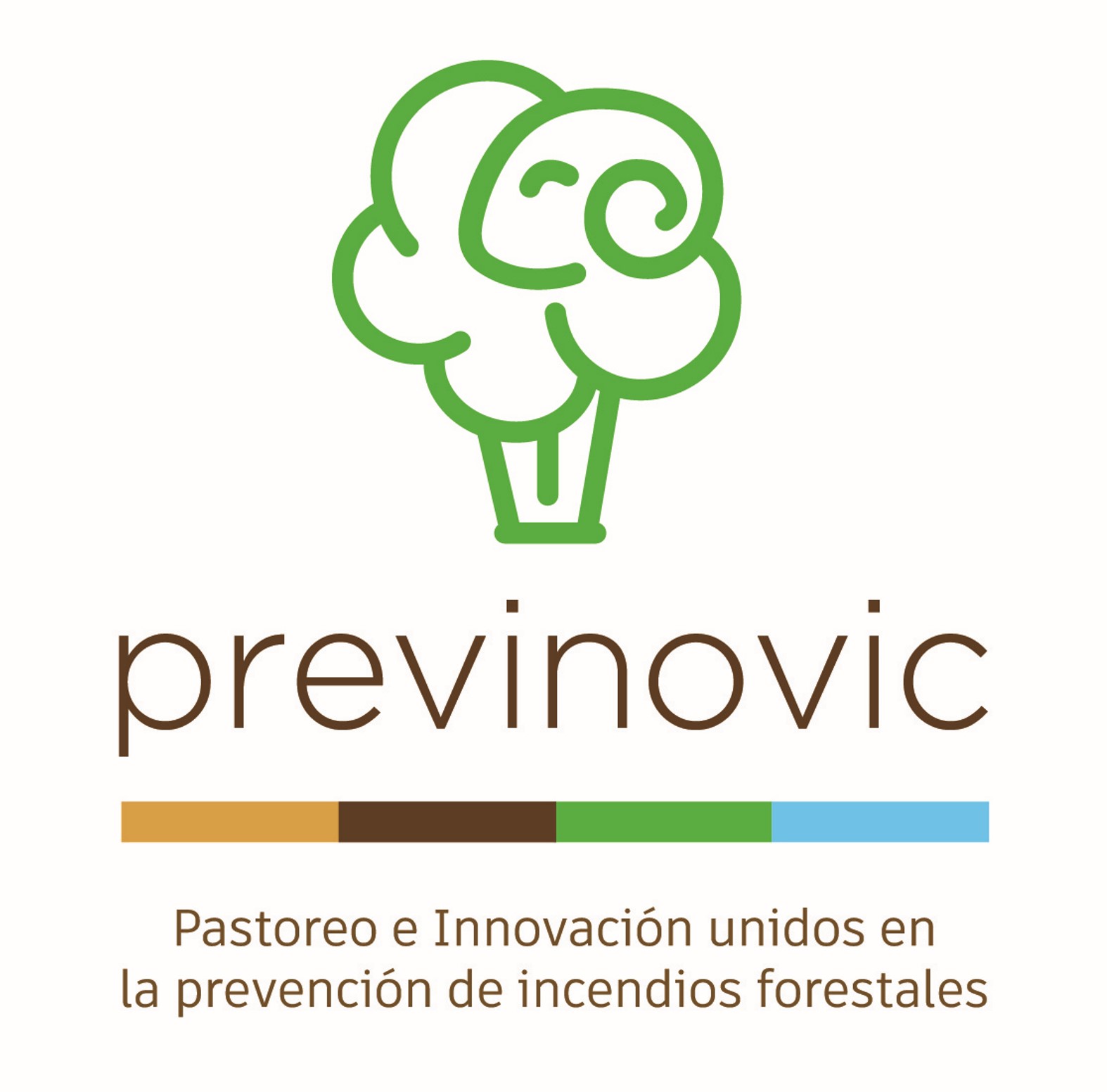
PREVINOVIC Operational Group: Application of extensive sheep and goat farming as a tool for fire control and prevention in Spain. Characterization and study of the benefits
- Type Operational group
- Status In progress
- Execution 2024 -2027
- Assigned Budget 593.715,00 €
- Scope Supraautonómico
- Autonomous community Andalucía; Aragón; Madrid, Comunidad de
- Main source of financing CAP 2023-2027
- Project website GO PREVINOVIC
The objective of this project is to analyze the entire ecosystem of small ruminant production, forest management associated with livestock farming, and livestock handling technology. Once this is understood, the project will promote and encourage the use of extensive small ruminant farming as a fire prevention tool in Spain.
The project works along two lines of work. Through the first line of work, we will understand the reasons why different programs have greater or lesser impact, the opinions of all stakeholders, and their impact on prevention in the medium and long term. Our goals are to: Raise awareness among all groups involved: livestock farmers, forest managers, local authorities, etc.; Demonstrate the needs of livestock farmers participating in prevention schemes so that governments can take them into account, as well as the limitations faced by forest managers; and understand the assessment of other ecosystem services associated with this grazing activity. Analyze possible grazing schemes that complement those currently being implemented, as a viable alternative to the traditional system.
The second line of work aims to complement the previous one by demonstrating different livestock management options for reducing biomass, adapted to the specific conditions of four different forest ecosystems on the Iberian Peninsula. Each will work with different species, stocking rates, and management systems.
In addition, we will apply different digital systems based on the use of geolocation collars: To verify the real effect of the use of understory biomass resources by small ruminants in different ecosystems, verifying the percentage of biomass reduction using drone technology. To obtain data on biomass reduction, by species and management systems, for use both in livestock production and by forest managers.
Raise awareness among producers and all stakeholders about the potential uses of these resources. Develop a small ruminant management guide for fire prevention in different forest environments.
Evaluate new livestock herding technologies, alternatives to guided grazing, for use in forest fire prevention strategies and analyze the associated costs.
- Block 1. Compilation of studies/projects or programs carried out on grazing for fire prevention. Selection of successful and unsuccessful cases of these programs. Compilation of statistical information on the prevalence and incidence of fires over the past 10-15 years.
- Block 2. Conducting surveys on fire prevention programs using grazing and on the perception of ecosystem services. Analysis of the results of all the information. Preparation of a report on fire prevention programs using sheep and goat grazing.
- Block 3. Conducting surveys for participating and non-participating livestock farmers in the fire prevention programs in the study areas. Preparing reports to characterize farms.
- Block 4. Conducting surveys among livestock farmers who graze in different Spanish forest ecosystems. Analysis of the results. Developing proposals for the design of payment schemes for grazing services for fire prevention.
- Block 5. Analysis of costs and results of grazing.
- Block 6. Development of several pilot projects: a pilot in the Sierra Norte of Seville/in the León Mountains/in the Aragonese pre-Pyrenees/in the Lugo Mountains.
- Block 7. Development of the Guide of recommendations for the management of small ruminant livestock as a strategy for preventing forest fires.
- Block 8. Study of the implementation of individual collar technologies that provide virtual fencing through satellite movement monitoring. Comparison of the feasibility of livestock movement control technologies.
Fire prevention in the Mediterranean has traditionally been carried out through the construction and maintenance of firebreaks, linear structures that break the continuity of vegetation to slow the spread of fires. The maintenance of these linear infrastructures is costly and is carried out mechanically. In recent decades, various experiments have sought to incorporate extensive livestock farming as another tool for fire prevention. Herbivores are capable of reducing fuel load through grazing, browsing, and trampling (Rouet-Leduc et al., 2021; Mancilla-Leyton et al., 2012). Extensive livestock farming contributes to clearing shrub areas in forested areas (Lasana et al., 2018). Thus, grazing shows enormous potential for reducing woody biomass and fire risk (Celaya et al., 2022).
All of this is within the framework of properly managed silvopastoral systems (Rigueiro R. et al., 2005). Maintaining or promoting grazing by domestic or wild herbivores is a promising tool for cost-effectively reducing the risk of forest fires while providing other ecosystem services (Rouet-Leduc et al., 2021). The national legislation regulating all forest land use is Forest Law 43/2003, amended by Law 10/2006. It establishes pastures as just another type of forest use.
As such, it is the responsibility of the competent bodies of the regional governments to regulate their use. The law requires that the use of pastureland be included in the corresponding forest management instruments or forest resource management plans. Pasture management can be incorporated into the forest fire prevention, monitoring, and suppression plans of the regional governments. The legislation of the regional governments is broader and more diverse depending on the territory.
However, it is common to find forestry laws and regulations governing forest resource management plans, laws or decrees on forest fire prevention, and decrees specifically regulating the use of pastures on forest land, as well as the administrative authorization regimes, where applicable.
Promote the use of extensive small ruminant farming to prevent fires in Spanish ecosystems, fostering interaction among professionals and utilizing new technologies.
- To understand the status of Grazing Programs or Projects related to fire prevention in the sheep and goat sector in Spain.
- A report will be generated containing all the collected documentation. Identify the economic, environmental, social, and cultural factors that must be considered when designing fire prevention strategies.
- A survey will be designed and completed to gather information, with the ultimate goal of creating a report to show the status of grazing as a fire prevention strategy.
- Technical and socioeconomic characterization of livestock farms participating in fire prevention programs.
- The surveys conducted will provide a description of the sector in Spain.
- Design of innovative grazing schemes for fire prevention.
- A specific survey will be designed for this purpose, which will provide information for generating a report to collect proposals and support the design of grazing payment schemes to prevent fires in Spain.
- To evaluate the cost and cost-effectiveness of using small ruminants to prevent fires in five Spanish forest ecosystems.
- A report will be generated to support the sector to present the associated costs and farmers' assessment of the currently implemented system model.
- Average percentage of natural biomass reduction eliminated after the passage of small ruminants with different management strategies.
- Development of pilot projects representing different types of Spanish production. Relevant information will be obtained (growth in forest cover, benefits and difficulties encountered by livestock farmers, etc.) to prepare individualized results reports on the impact on forest ecosystems.
- Development of a guide for the use of small ruminants in fire prevention.
- This open-access guide will provide a series of recommendations for the sheep and goat sector to support the successful implementation of fire prevention programs.
- Technical and economic evaluation of the application of satellite technologies for guided grazing in forest areas.
- Preparation of a report on the conclusions regarding the implementation of technologies for grazing management: problems and opportunities.
- Coordinator/entity name: INTERPROFESSIONAL AGRO-FOOD ORGANIZATION OF SHEEP AND GOATS (INTEROVIC)
- Postal address: C/ AGUSTIN DE BETHANCOURT, 17, 6th floor. 28003, MADRID
- Coordinator/entity email: interovic@interovic.es
- Telephone: 663304294
- ORGANIZACIÓN INTERPROFESIONAL AGROALIMENTARIA DEL OVINO Y CAPRINO (INTEROVIC)
- ORGANIZACIÓN INTERPROFESIONAL AGROALIMENTARIA DEL OVINO Y CAPRINO (INTEROVIC)
- VIDAR Soluciones Agroambientales SLU
- CORSEVILLA, SOCIEDAD COOPERATIVA ANDALUZA
- EA GROUP SC
- OVIARAGON SCL
- OVICA - ASOCIACIÓN DE CRIADORES/AS DE OVINO Y CAPRINO DE GALICIA
- Universidad de Zaragoza






